Kent AGS Show, 2015
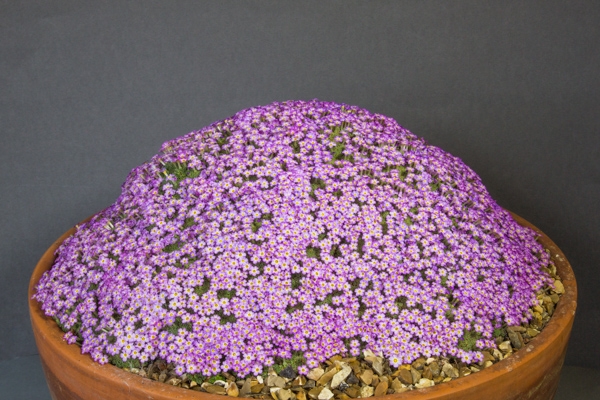
Frequent attendees of this, the earlier of the two Kent shows, will know that the intake can vary markedly from year to year, usually measured by the balance between Dionysia and Saxifraga. This year the later won with no less than 63 individual entries of this stalwart genus of the first shows, though it must be said that the quality of the dionysias shown was exceptionally high. Indeed, the Farrer Medal, along with the David Wisdom Trophy for the best pan of Primulaceae went to one of these, a 26 year-old Dionysia curviflora, grown originally from a cutting of JCA 2800/3 and shown by Nigel Fuller. He says that the secret of success with Dionysia is constant propagation – keep the material moving. Nigel favours a compost of 50% grit, 25% pumice and 25% John Innes no. 2, watering directly into the pot from the end of February to around June, after when he reverts to keeping the plunge material moderately moist.
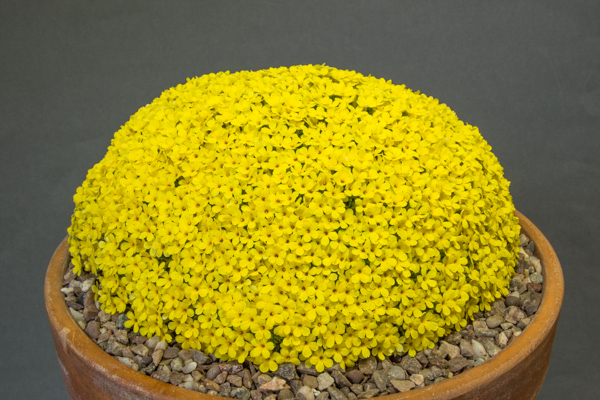
Another of the genus to catch the eye was D. ‘Gerben’: those who grow it will know of its tendency to form a comparatively loose cushion which flowers intermittently, but here we were treated to a solidly flowered, tight-looking specimen shown by Eric Jarrett. In effect a dwarf form of D. aretioides, perhaps with an input from D. tapetodes, it responds best to a compost made up of 80% grit with 20% JI no. 2 (JI no. 3 is too rich).
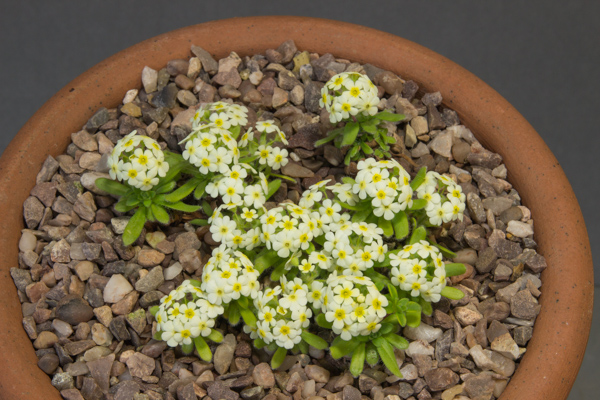
Androsace species are at their best in April and early May, but the earliest awaken in mid-March. Another good exhibit, again exhibited by Eric Jarrett, was Androsace aff. flavescens – the qualifier indicating its presently uncertain nomenclature status, for apparently it differs most obviously by the shape of its cream flowers (these are yellow in the nominate species, native to the Karakoram and Xinjiang). Grown originally from Holubec seed sown four years ago, it is now making soft, typically stoloniferous growth which makes this a fairly straight-forward species to propagate; grown in 70% grit to 30% John Innes no. 2, it occupies a plunge frame, kept covered until the very worst of winter has passed.
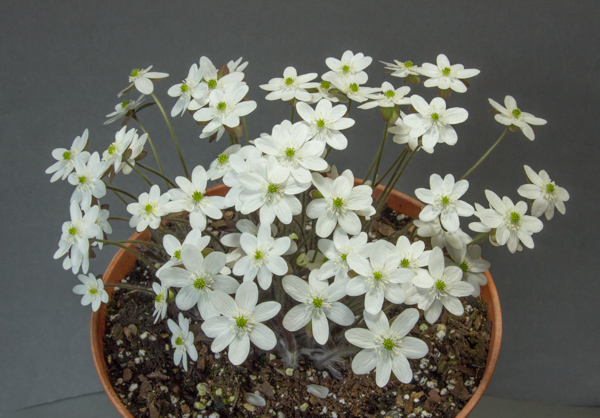
The Sastre Trophy for most first prize points in the Novice Section and the Invicta Trophy for the best plant therein were both won by Rosemary Hillyar; her floriferous plant of Hepatica acutiloba would not have looked out of place in the Open Section such was the quality of her well-flowered white form of this early flowering denizen of eastern North American woodlands.
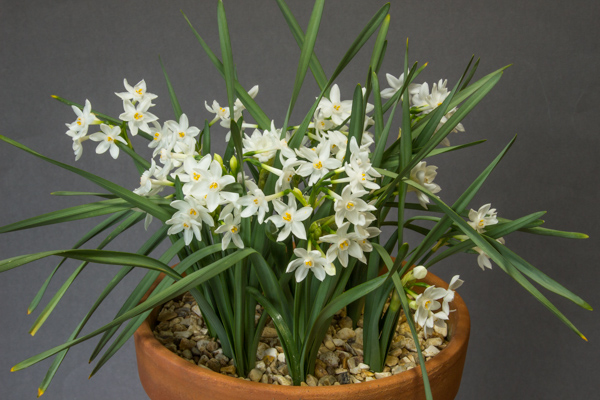
Doing the double carried through to the Intermediate Section, with Audrey Dart carrying off the Jean Elliott Trophy for most first prize points and the Longfield Trophy for the best plant, a panful of a beautiful dwarf form of Narcissus panizzianus. She had received the bulbs only the year before, and had overcome the notoriously capricious flowering proclivity of this species by growing them in a mix comprising John Innes no. 3, grit and perlite, the pot kept under glass and well-watered.
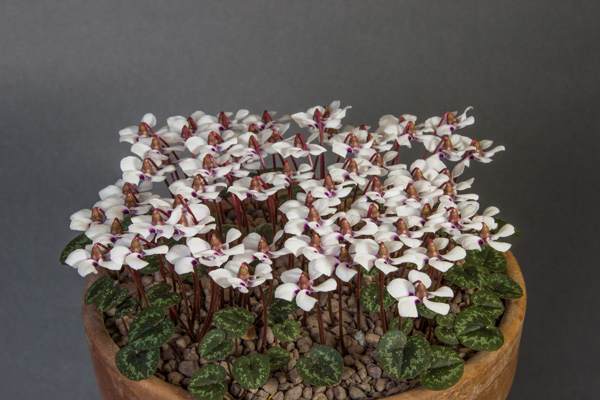
Ian Robertson is no stranger to success on the show bench: all manner of Cyclamen are his forte. The form of Cyclamen alpinum f. leucanthum he presented was a very distinctive creature; the flowers appearing at a superficial glance to have slightly wilted, even though they were freshly opened, giving it the pronounced ‘propeller-shape’ that the synonym C. trochopteranthum suggests, the evenness of flowering giving the impression that it had been displayed with the aid of a spirit-level. This won the Northdown Trophy for the best plant in a 19cm pot against strong competition.
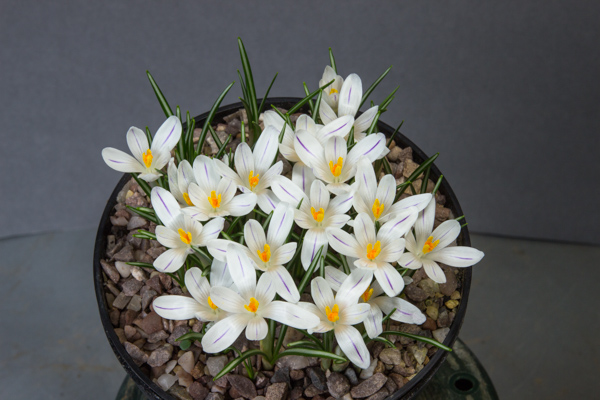
The Crocus Award (the supply of silver spoons once accorded has evidently run out), not surprisingly for the best pan of Crocus, went to a delightful form of Crocus vernus subsp. albiflorus shown by Robert Rolfe. A reliable flowering clone, it increases well for Robert, who grows this plant in a moist plunge-bed under glass.
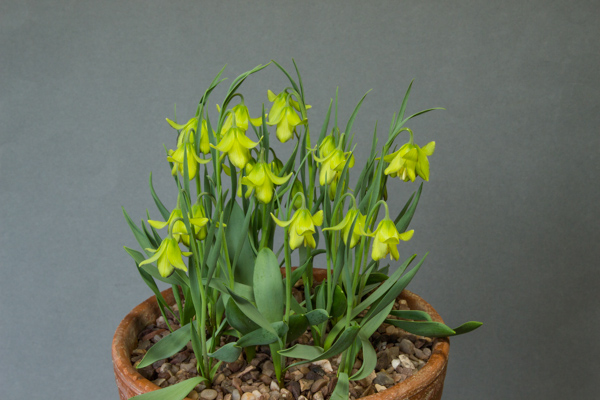
He also gained a Certificate of Merit for his panful of Fritillaria carica, with 20 dainty hanging blooms each giving the impression that they had been disturbed and were about to take flight, for in this southerly form, dating some 30 years from Baba Dağ, the segments are flicked back and mascara-lined at their margins. Originally from one bulb obtained in 1988, it produces a modest number of rice-grain offsets best grow on separately (this avoids the appearance of a ‘too leafy’ exhibit), in a John Innes/sand/perlite/ grit mix.
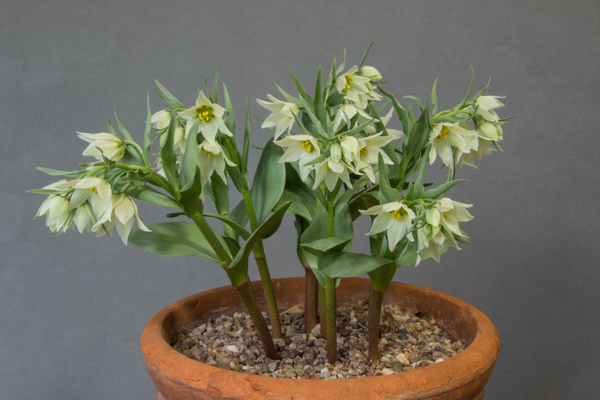
Another Certificate of Merit was awarded to a second pan of Fritillaria, this time F. bucharica shown by Jim McGregor. Originally purchased as a single bulb in 1993 as a ‘large-flowered form’, Jim grows this in a 50/50 mix of grit and John Innes no. 2 which he occasionally liquid feeds ( when he thinks of doing so) and even less occasionally repots. Plunged in a clay pot under glass, the bulbs are dried off a little when growth has finished for the year.
The Artistic Section is always well supported at this show and this year was no exception. The judges discussed long and hard the many and varied exhibits and finally settled on an aggregate win in the Intermediate Section for Vincent Daniels who received the Artistic Award. The equivalent in the Open Section, the Rosemary Powis Trophy, went to the hard-working and ever-present Jon Evans, whose entries included images of a surprising population of Gentiana acaulis that prospers in light woodland on the North Downs.
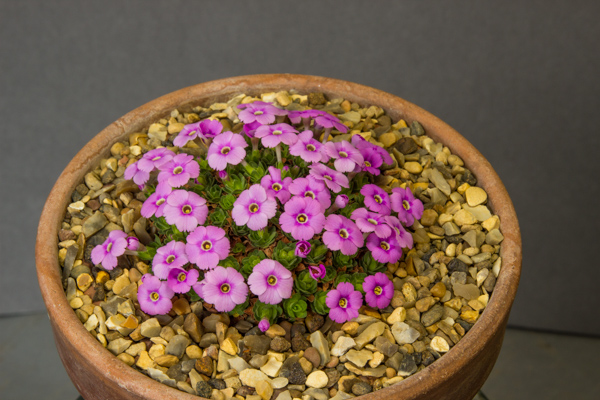
Paul and Gill Ranson are well-known for their mastery of cushion plants and Primulaceae, Dionysia in particular, from mature specimen plants through those raised from seed down to exhibits new and rare to cultivation. Their deployment of these won them the Bluebell Hill Trophy for the most first prize points in the Open Section. [Photo: D. 'Hyperion']
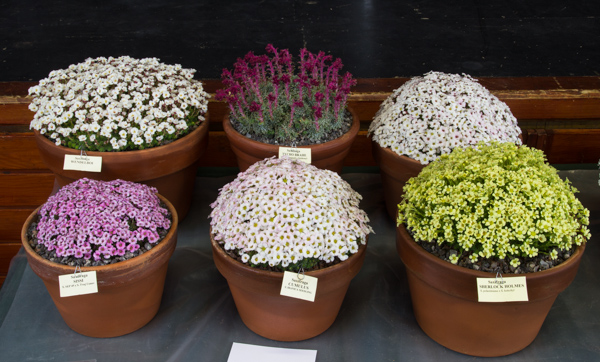
I have left mention of the AGS Medal for class 1 till last, first place going to a superb collection of saxifrages, as this was awarded to David Hoare, the show secretary of both Kent shows (spring and autumn). This was David’s twenty-fourth show at the sharp end of proceedings. David insists that it’s all about having a good team, to which he would like to send his thanks. But I would like to take this opportunity, on behalf of all exhibitors, to thank him for presenting us with yet another first-rate show at which to share our plants with each other and other gardeners in the south-east of England.
Author: Ray Drew
Photographer: Jon Evans
